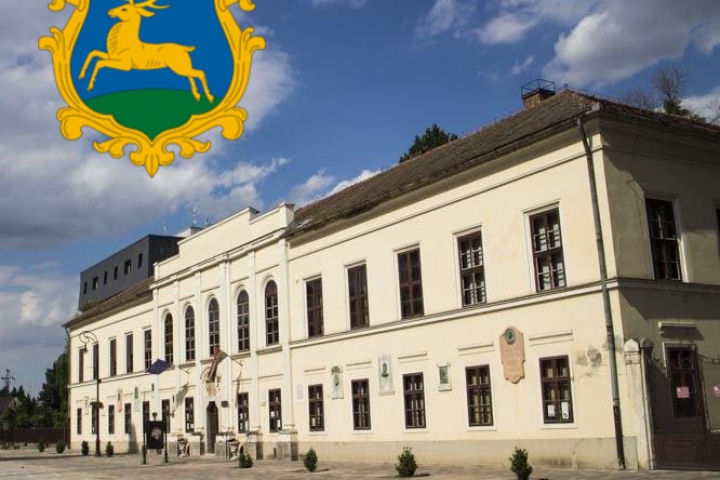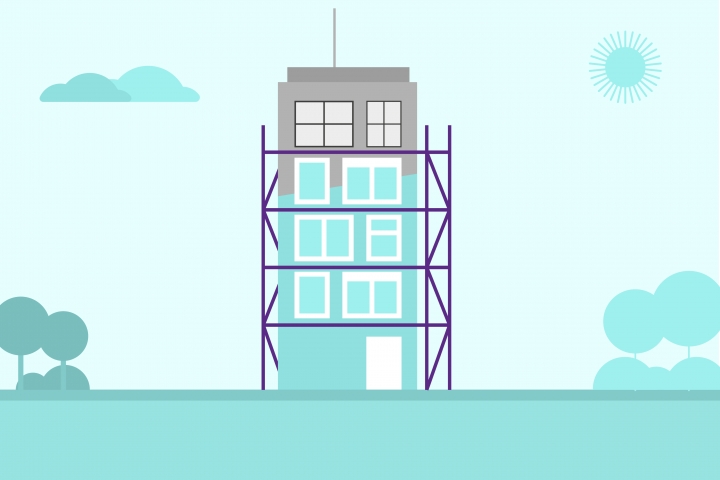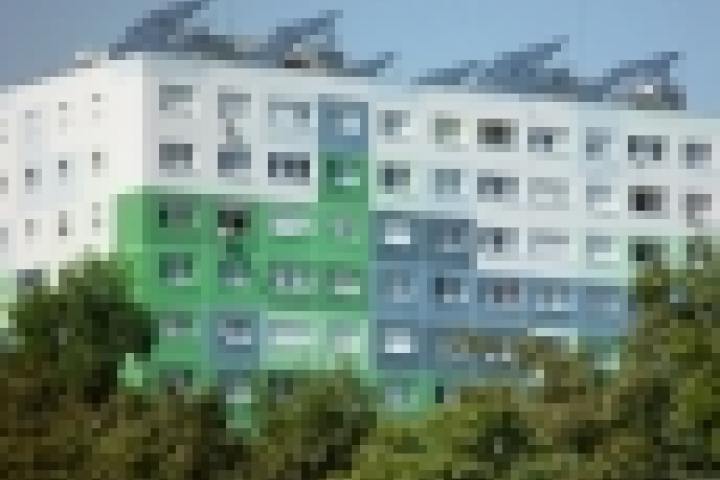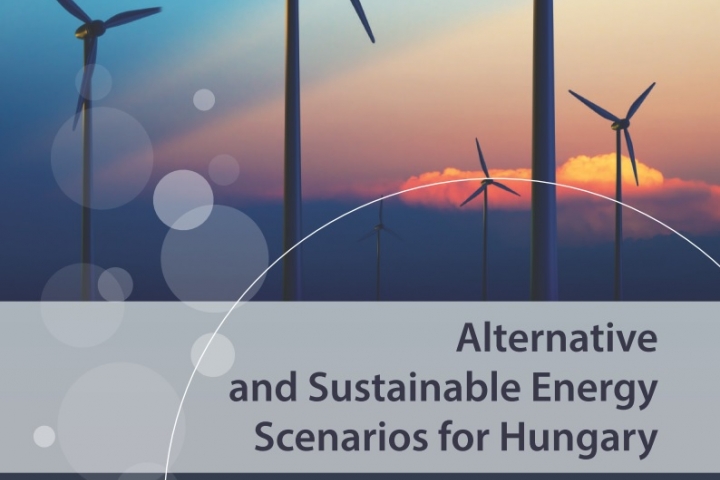First-hand experiences from the “Faluház”
886 apartments, 5,600 m2 of windows, 24,000 m2 facade surface and residents who would fill a smaller municipality – the Faluház apartment building in Budapest’s Óbuda district is enormous, which is one of the reasons it could be renovated in the framework of an EU project. The Energiaklub participated in the project and was a close observer of the renovation of Hungary’s larger block building and of the first two years after completion.
The Faluház before
The building was built in 1970; it was considered an example of Socialist apartment developments; the leaders of that time were very proud to have demolished the one-storey houses of the neighbourhood, mostly without amenities, and erected a new, modern building with 15 staircases to house shipbuilders and textile factory workers. The 9 different heating systems installed at the time of the construction were unified in 2004 and 2005 in the whole building. This means that the former one-pipe heating system was transformed into a two-pipe one, and installed thermostatic valves on the radiators so heating can be regulated in each apartment.
At the prices of the period, this investment cost approximately 60 thousand forints per apartment, and the heating centre was modernised by the district heating provider. It is important to know that the heating centre in buildings with district heating is owned by the service provider, therefore the necessary repairs and maintenances are the responsibility of the provider, and the consumers pay the provider for these continuously (typically as part of the basic fee). The amount of heat consumed in the Faluház in the years following the modernisation of the heating system slowly started diminishing: the heating heat consumption of the building was approx. 10 percent lower in 2008 than in 2004. The thermal energy used for producing hot water also decreased in these years, but according to the data the sole reason for this was that – possibly due to price increases – households started to economise, therefore the building used less hot water in total during this period.
The building is born anew
The local government of Óbuda applied in 2006 along with Amsterdam and Sofia to the European Union’s “Concerto” programme to conduct a model project, a complex investment aimed at both energy efficiency and renewable energy use and follow up on its technical, environmental and social effects. Óbuda undertook a modernisation involving 800 to 900 apartments within the project, therefore after winning the tender the district had to find the right building or buildings. The local government decided on the Faluház, partly because of its enormous size, and because of its central location as it stands at the gate of Óbuda so that people arriving to the area see the Faluház first.
3 years after winning the EU tender, in the summer of 2009 the mega-project was launched, and it was completed in only 6 months, by December 2009. The Hungarian project was the only one to be completed on time of the countries participating in the project.
In the course of the modernisation, they installed a 10 centimetres thick Styrofoam thermal insulation on the facade, the roof and the basement ceiling, and rock cotton was installed on the walls above doors and windows for fire safety purposes. The thermal insulation capacity of the facade increased greatly as a result, and is now competitive with the walls of newly constructed buildings. The old windows were replaced by more modern plastic windows, therefore – at least in theory – the windows transmit 50% less heat. The investment project included the installation of a system using renewable energy sources in accordance with the tender undertakings. The heat pump system was rejected due to unfavourable geographic attributes and the high costs caused by them, and they eventually decided to install a solar thermal collector system to supplement hot water production. So-called cost distributors were installed in each apartment to measure the thermal energy used in them – which later caused some disputes among the residents. The problem arose from last year’s practice where the radiators were completely turned off in some of the apartments, whereas others kept them on, thus somewhat heating the neighbouring flats as well.
The complete project had a cost of approx. 1.3 million forints per apartment, with a total of close to 1.2 billion forints for the whole building.

Results
The heating centre and the thermal collector system constantly measure the amount of heat used and produced. In order to really be able to compare the consumption of different years the measurement data have to be corrected, filtering out the impact of differences in weather. The following graph shows how much heat the building would have consumed in each year if the weather had been the same as in 2004.

It can be seen that the building’s heat consumption began to diminish instantly after the heating modernisation of 2004-2005, but of course the largest decrease occurred after 2009. (There was a significant decrease already in 2009, but this may be misleading as the renovation was done in this period so the building’s usual heat consumption was disrupted.) On the whole, in 2011 the thermal energy used for heating and hot water production decreased by almost 30 percent in comparison with that of 2011. But if we compare these data to those of 2004, the Faluház’s original state, the change is approximately 45 percent. The “Lakcímke” energy certificates prepared by the Energiaklub reflect that the apartments already achieved category D-E after the modernisation of the heating system, and moved on to category A-B as a result of the 2009 renovation on the scale of I to A+.
This – albeit falling short of the expectations – is a significant amount saved, which is felt by the residents directly.
Money that stays in the residents’ pockets
Let us put a figure on these savings and see how much people living in the Faluház building would pay without any of these renovations, if everything had remained as it was before 2004. According to the data, the heat consumption per apartment – with an average area of 50 m2 – was approx. 40 GJ annually: at today’s prices this would cost approx. 220 thousand forints net to households. As a result of the renovations, the average heat consumption per apartment dropped to 22 GJ, therefore the annual district heating bill decreased to approximately 150 thousand forints net. (To be fair, this is achieved in part by the 15% basic fee discount given to the Faluház by the district heating provider.)
Residents often say that their bills dropped to almost half, but it is important to note that the renovation coincided with the change in legislation diminishing the VAT content of district heating to 5 percent. Thus, whereas the post-renovation annual bill of 150 thousand forints net would be 190 thousand forints gross with a 27% VAT, it is only 156 thousand forints gross with 5% VAT. Therefore the perceived drop in costs is not entirely a result of the renovation; it is also the effect of the VAT decrease that users feel (as well as the state as this tax reduction leaves a gap in the budget).
Comparing the investment costs with the district heating savings we can see that the estimated payback period of the project exceeds 20 years at the current prices and results. If we regard the situation from the residents’ perspective it is much more favourable as they provided less than one third of the total costs of the investment, while they are the sole beneficiaries of the savings – they can have return on their investment within 5 to 6 years. (This, of course, depends on future consumption habits and the method of cost distribution, and can vary from household to household.)
Financing construction
The EU subsidies only covered part of the investment costs, therefore the building applied to the Hungarian “panel programme” for block buildings as well in 2008, and won. This, however, was still not sufficient for all the expenses therefore the local government and the residents had to contribute money as well.
The building residents took out a bank loan with discounted interest in the framework of the panel programme for an eight-year term. For five years, 70% of the base rate is paid by the state and the rest by the local government, and after this period the residents will have to pay the full interest. Until then the majority of residents put 3-4 thousand forints monthly into home savings accounts, and at the end of the five-year period they will use the money saved in this account to make bank payments. (This is collateral for the loan.) The residents made the savings account payments part of the common charges to ensure that everybody pays the instalments.
It should be noted that this is a unique and unrepeatable investment in terms of financing as the European Union only contributed to financing because of the experimental, model character of the project. The costs undertaken by the EU will have to, in other buildings, be paid by the residents, the local government or the state.

Challenges
Operation of the building poses constant challenges to the maintenance team of the Faluház. First of all, the system must be continuously supervised and maintained, requiring a suitable operator and technicians. This way technical problems (which we will list in a separate article) can be prevented or promptly repaired. A continuously operating computer monitoring system is also necessary to point out failures and monitor the consumption of residents.
In buildings of this age the aging of different building parts and equipment is sooner or later an unavoidable issue, causing significant trouble to the resident community. The Faluház is no different in this aspect: the 40 years old pipe strings have significant heat loss, decreasing the efficiency of the hot water system as well, but the panel programme did not offer subsidies for this purpose. The old ventilation system, the low-efficiency ventilators and the old engines had difficulties drawing away the humidity increased as a result of the thermal insulation of the building, therefore the residents replaced the ventilation chimneys and engines in 2011 using their own funds. Further savings could be achieved by modernising the staircase lighting and the elevators, and replacing the entrance doors, but the total cost of necessary renovations would reach the amount already invested according to the maintainers. (The majority of radiators have already been replaced by the residents individually.) Last summer it was discovered that although it does not reach the originally planned performance level, the solar thermal collector system produces more heat than needed. Solution to this problem is still an issue for the future.
Lessons, positive impacts
For residents, the investment resulted in an improvement of comfort feeling beyond the specific financial benefits: they report that it is better to go home into the building now that it looks nicer. It is also an important factor that they can probably sell their apartments on the market at better prices than apartments in block buildings that have not been renovated. It is an important lesson that if a building takes into account the potentially arising problems, retrospective corrections, and sets the exact scope and details of repairs covered by the guarantee in the contracts with contractors, problems can be solved after they arise.
For the state another positive effect beside the energy savings was that the project created 200 jobs for workers for 6 months and – as black labour, which is unfortunately quite common in the building industry, was impossible because of the different tender frameworks – the budget received the taxes and fees from wages, as well as the VAT of the products used.
Possibly the most important benefit of the project is that the effects of the project must be measured, monitored, and the public must be informed about these continuously, which is not the case in Hungarian tenders. This obligation makes it possible now for other buildings, local governments and state decision-makers to receive information on the experiences of this gigaproject, allowing them to draw conclusions and plan investments and shape tender systems accordingly.
The Faluház model project has yielded valuable experiences to everybody, but it is still important for residential communities seeking energy savings to assess the state, unique features of their building with an energy management expert, and initiate renovations based on the professional’s proposals. The fee of an expert is insignificant in comparison with the headaches and superfluous expenses of a badly planned investment.
The project in numbers
- More efficient building shell - The thermal insulation of the facade and the roof was done with 10 centimetres thick Styrofoam insulation, improving the heat transmission of facade walls from 0.7 W/m2K to 0.3 W/m2K, and that of the roof from 0.5 W/m2K to 0.2 W/m2K.
- Approximately 90 percent of the total window surface area was replaced, that is, 1,800 old windows (U=3 W/m2K) were replaced with plastic windows with a heat transmission of 1.4 W/m2K, with 5 air pockets.
- Heating modernisation - The district heating provider performed the modernisation of the heating centre, and the residents had digital individual meters installed on the radiators.
- Renewable energy - 125 6 by 2 metre, 302 kilogram solar thermal collectors were installed on the roof with a surface of 1,515 m2 and a capacity of 1,128 MW. The 100 m3 buffer tank necessary for the system was successfully placed in the heating centre, and automatic connection was established between the old and the new hot water systems.
(Author: Orsolya Fülöp , Energiaklub, datas: BECO Hungary, Attila Mórotz )






